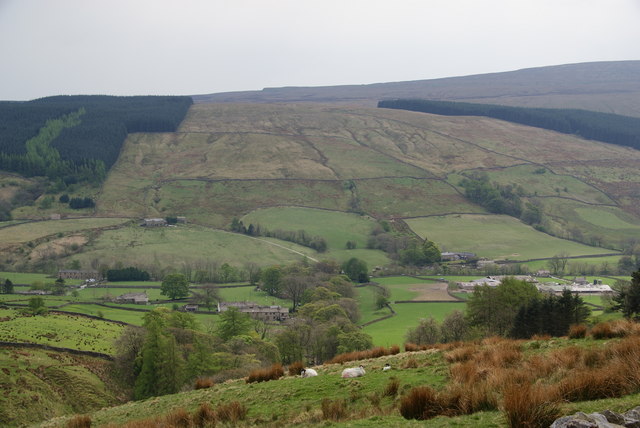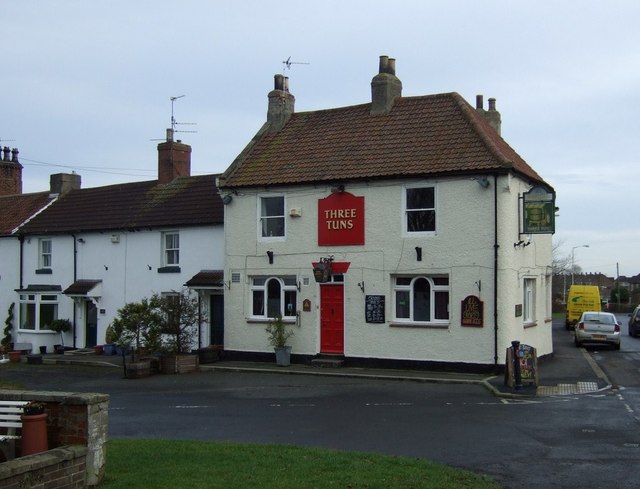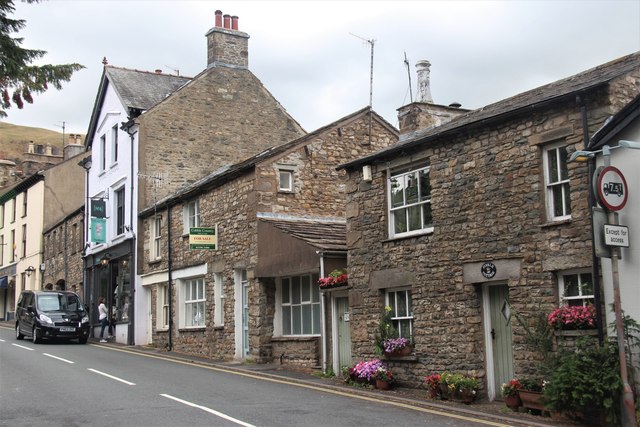Topics > Civil Parishes in Cumbria > Sedbergh Civil Parish > Sedbergh, 1848
Sedbergh, 1848
SEDBERGH (St. Andrew), a market-town and parish, in the W. division of the wapentake of Staincliffe and Ewcross, W. riding of York; containing, with the chapelries of Dent, and Garsdale with Grisdale, 4,836 inhabitants, of whom 2,268 are in the township of Sedbergh, 10 miles (E.) from Kendal, in Westmorland, 77 (W.N.W.) from York, and 260 (N.W. by N.) from London. The town is neatly built, and consists of one street. Two cotton-mills, the property of James Upton, Esq., of Akay Lodge (a beautiful residence), employ 250 hands, and are propelled by water-power: one of them, called Old Milthorpe, was erected in 1797; the other, Birks Mill, was built in 1802, burnt down in 1825, and rebuilt in 1828. A mill for coarse woollens employs 25 persons. The market is on Wednesday; and fairs for cattle are held on Feb. 26th, March 20th, April 20th, and October 29th. The parish lies in a mountainous district, on the rivers Rother or Rawthey, Dee, and Clough; and comprises by computation 50,000 acres, whereof more than 30,000 are uninclosed and moorland. In Sedbergh township are 22,521a. 2r. 25p., of which 14,550 acres are common or waste; 750 are arable, 383 woodland, and 32 glebe. The surface of the parish is boldly varied, and the scenery abounds with features of romantic grandeur, backed by the Howgill fells, rising majestically 2,320 feet above the town. The four hamlets of Marthwaite, Frostrow and Soolbank, Cautley and Dowbiggin, and Howgill with Bland, are in the township. The Lowgill station on the Lancaster and Carlisle railway is distant five miles north-westward from the town.
The living is a discharged vicarage, valued in the king's books at £12. 8.; net income, £184, with a house; patrons and impropriators, the Master and Fellows of Trinity College, Cambridge. The vicarial tithes of the township have been commuted for £129, and the glebe consists of 32 acres. The church, from its Norman arches and piers, is evidently of ancient date; but seems to have been partially rebuilt, the windows being all of a debased character: a baptismal window of stained glass by Wailes, of Newcastle, was presented in 1844, by a stranger. The font, a beautiful specimen of Garsdale marble, has been restored; and marble steps to the altar have been added by the Rev. G. Platt, the vicar. At Cautley, Dent, Garsdale, and Howgill, are other incumbencies. There are places of worship for Independents, Methodists, and the Society of Friends.
The free grammar school was originally founded by Roger Lupton, D. D., provost of Eton College in the reign of Henry VII.; and the lands with which it was endowed having been sequestrated by Henry VIII., the school was refounded by Edward VI., who endowed it with the estates belonging to several dissolved chantries. The management of the property is vested in twelve governors, who reside in the township, and by whom the whole of the rents, about £600 per annum, are paid to the head master, the usher receiving out of them £100 yearly. The school is free to boys from any parish on the payment of entrance fees and "cockpennies." The appointment of the master belongs to the Master and Fellows of St. John's College, Cambridge, where are three fellowships and ten scholarships appropriated to students from this school; there is an exhibition to either of the universities, for natives of the township, and the school sends a candidate for Lady Hastings' exhibitions. The present head master is the Rev. J.H. Evans, M. A. About £90 per annum are distributed to poor householders in the township, not receiving parochial relief, at Easter and Christmas; £15 per annum are given to poor children at Whitsuntide, for clothing, and about £8 are expended in bread for the poor. These sums are paid from bequests left in small sums from time to time, and invested in real property. The remains of a camp are visible round a conical hill called Castle How Tower; and as a curiosity of the neighbourhood may be mentioned Dowker Fell cave, of considerable extent, with a stream of water passing through: the roof, however, is broken in the centre.
Extract from: A Topographical Dictionary of England comprising the several counties, cities, boroughs, corporate and market towns, parishes, and townships..... 7th Edition, by Samuel Lewis, London, 1848.

Co-Curate Page
Dent Chapelry, 1848
- DENT, a parochial chapelry, in the parish and union of Sedbergh, W. division of the wapentake of Staincliffe and Ewcross, W. riding of York, 5 miles (S.E. by S.) from …

Co-Curate Page
Cowgill
- Overview Map Street View Cowgill is a distributed village in the South Lakeland area of Cumbria, located about 3½ miles east of the village of Dent and 7 miles south-east …

Co-Curate Page
Sadberge
- Overview About Sadberge Map Street View Sadberge is a village located about 3 miles north-east of Darlington and 5 miles south-west of Stockton-on-Tees. Sadberge lies within the Borough of Darlington …

Co-Curate Page
Garsdale, 1848
- GARSDALE, a chapelry, in the parish and union of Sedbergh, W. division of the wapentake of Staincliffe and Ewcross, W. riding of York, 6 miles (E.) from Sedbergh; containing 681 …

Co-Curate Page
Cautley
- Overview Map Cautley is an area and distributed community, located in the valley of the River Rawther, to the north-east of Sedbergh. It is in the ceremonial county of Cumbria …

Co-Curate Page
Howgill, Sedbergh
- HOWGILL, a chapelry, in the parish of Sedbergh, W. division of the wapentake of Staincliffe and Ewcross, W. riding of York, 3 miles (N.W. by N.) from Sedbergh. This district, …

Co-Curate Page
Fostrow and Soolbank
- Fostrow and Soolbank were districts of the ancient parish of Sedbergh, covering a wide geographical area to the east of the town of Sedbergh. Hawes Road (A684) runs through the …


Co-Curate Page
Dent Chapelry, 1848
- DENT, a parochial chapelry, in the parish and union of Sedbergh, W. division of the wapentake of Staincliffe and Ewcross, W. riding of York, 5 miles (S.E. by S.) from …

Co-Curate Page
Cowgill
- Overview Map Street View Cowgill is a distributed village in the South Lakeland area of Cumbria, located about 3½ miles east of the village of Dent and 7 miles south-east …

Co-Curate Page
Sadberge
- Overview About Sadberge Map Street View Sadberge is a village located about 3 miles north-east of Darlington and 5 miles south-west of Stockton-on-Tees. Sadberge lies within the Borough of Darlington …

Co-Curate Page
Garsdale, 1848
- GARSDALE, a chapelry, in the parish and union of Sedbergh, W. division of the wapentake of Staincliffe and Ewcross, W. riding of York, 6 miles (E.) from Sedbergh; containing 681 …

Co-Curate Page
Cautley
- Overview Map Cautley is an area and distributed community, located in the valley of the River Rawther, to the north-east of Sedbergh. It is in the ceremonial county of Cumbria …

Co-Curate Page
Howgill, Sedbergh
- HOWGILL, a chapelry, in the parish of Sedbergh, W. division of the wapentake of Staincliffe and Ewcross, W. riding of York, 3 miles (N.W. by N.) from Sedbergh. This district, …







